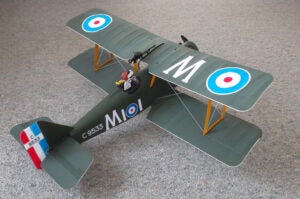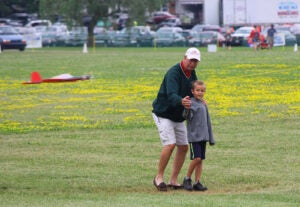 Sometimes when you set out to fix one problem you create one (sometimes many) more. That’s what I think is happening now as the FAA has said it will not extend the comment period for a controversial program that, essentially, treats model aircraft as drones. As the EAA says, “The rule would require most [unmanned aircraft systems], no matter whether they are ‘drones’ or traditional model aircraft, to carry equipment that identifies the device and broadcasts its location. Additionally, many would be required to be equipped with ‘geofencing’ systems that autonomously contain the craft within a defined altitude and lateral boundary.” Does that sound as crazy to you as it does to me?
Sometimes when you set out to fix one problem you create one (sometimes many) more. That’s what I think is happening now as the FAA has said it will not extend the comment period for a controversial program that, essentially, treats model aircraft as drones. As the EAA says, “The rule would require most [unmanned aircraft systems], no matter whether they are ‘drones’ or traditional model aircraft, to carry equipment that identifies the device and broadcasts its location. Additionally, many would be required to be equipped with ‘geofencing’ systems that autonomously contain the craft within a defined altitude and lateral boundary.” Does that sound as crazy to you as it does to me?
Actually, I’m getting ahead of myself.

If I asked for a show of hands among pilots asking how many got into aviation by building model airplanes, and then extending that hobby into flying radio-controlled model airplanes, I expect that well more than half the room would be extending limbs high into the air. I know, because I have asked this question at presentations and meetings all over the country. That, and the observation that just about every hangar or workshop I visit, has radio-controlled airplanes hanging from the walls or ceilings. Modeling is, and always has been, a gateway into full-scale aviation—just read any aviation biography and you’ll find that not only are future pilots born in a little farmhouse, but they got their start building balsa and tissue models.

So there is little doubt in my mind that young model aircraft builders and flyers are the future of aviation—its where kids develop an interest and passion for aviation. And passion is important because aviation is not easy and it’s not cheap—you need motivation to get in, and to stay in. What starts as a passion for models becomes a passion for light aircraft, which then becomes a path into the military or the long road through instruction, charter and eventually airline flying. And without pilots flying airliners our entire economy falls off a cliff. The general public doesn’t know this, but they would probably understand if they were told.
That brings us back to the FAA, which has proposed a set of rules that essentially requires registration and ADS-B type installations on model aircraft across the country. This has developed out of work done to regulate Unmanned Aerial Systems (UAS), or drones, over the last decade. The FAA has tried a number of different initiatives to control and regulate drones, yet it is hard to see that much has changed except for a proliferation of rules proposals and some bureaucratic registration systems that have met with mixed results. Sure, many law-abiding citizens have registered their drones and gotten licenses to fly them, but most of the problem drone reports have been caused by those who didn’t. A “bad guy” with a drone simply isn’t going to bother registering it—that’s pretty simple to understand.
The latest proposed regulations are out for comment right now, with a 60-day comment period that started on January 1. So far, in one month, it has solicited 7000 comments—a huge number for a proposal that has hardly been publicized outside of aviation circles.
It is a draconian proposal that has clearly raised a lot of ire. But it needs to raise more, so the EAA asked the FAA for an extension of the time period to allow more comments. The FAA very abruptly denied this request, saying that they will not allow an extension due to security concerns and the dire nature of the threat posed by drones.
Now folks, let’s take a step back. So far, in 10 years of drone awareness, there have been many reported suspicions of drone strikes on aircraft, yet only one or two that have been confirmed— worldwide. That is far below the number of bird strikes every week. Why do I bring up bird strikes? Well there is little that can be done about them. Yet we, as pilots, clearly accept the small risk because if we didn’t we wouldn’t fly at all. Drones are no different, unless you argue that there are malicious operators out there intentionally trying to hit airplanes with their drones. Sure, that is clearly a possible scenario, but let’s be honest—its pretty darn unlikely. You’d really have to have made an enemy for someone to make that sort of effort to take you out. And if you were going to do that, you certainly wouldn’t register it or let it transmit its ID and position.
So in a 10-year process in which little progress has been made, why suddenly do we need to close comments right now on a proposal that is clearly unpopular? I think I know: Because the longer you leave comments open, the more negative comments you get, and the more unpopular it obviously becomes. Yup, that’s the way it works in government—and as a former federal civil servant, I have a little insight.
This is not meant to paint the vast number of FAA personnel in a bad light—they are, by and large, great people doing good things for aviation. But they are directed by political forces beyond their control. Remember, policy is usually not created by civil servants, it is created by politicians; it’s just implemented by civil servants. When we see obvious bullying tactics by an agency toward the public, that is generally a sign of political pressure not civil servants run amuck. Civil servants aren’t allowed to run the mucks anyway…. (It’s above their pay grade.)
Regardless of your opinions on how drones and model airplanes should be regulated, the bottom line is that if you want to have a say in how your government regulates them, it is time to go make your comments and let your voice be heard! (There are instructions for submitting comments on this page, via email, regular mail, hand delivery, courier and, yes, fax.) Comments are due by March 2, 2020.
No matter how you do it, do it soon. You’re not getting an extension. That has been made abundantly clear.














Like many of you, I built radio control airplanes back when you had to build them or buy them from someone who had. So much gratification and pride in seeing your hard work take to the air. Not so much like the ARF’s of today’s world. But regardless of what generation you come from, model aviation is History, it is Present, and with all our help it can continue to be in our Future. It is a wholesome rewarding enjoyable hobby spent with good folks of the same interest. What you are witnessing here is the government’s attempt to put yet another nail in your freedom coffin. I understand the FAA’s concern in this matter but they are quick to destroy a good thing that will ultimately result in retaliation instead of cooperation. Not to mention the industry as a whole will ultimately fail. Drones and airplanes are two separate interest groups with different ideals and goals. The FAA must see them as such. Voice your concerns to put a stop to this action.
It’s all about the big money that wants to put last delivery vehicles and air taxis in the air and wants to have the space below 400 feet without any obstacles.
I too enjoyed model aviation prior to my career in aviation. I returned to it a couple of years ago. I can tell you this really is about making the threat bigger than it is so a few rich people can get richer.
1. R/C airplanes have not been involved in any incident I have read about. It is not a Beyond line of sight vehicle.
2. There is an alliance of commercial drone operators who want to legally take everyone’s airspace for their own profit.
3. After years of working with external load operations that require FAA site by site approval you cannot tell me commercial drone operations are safe or that they will get that type of approval for every delivery site.
4. ALL EXTERNAL LOAD SYSTEMS FAIL AT SOME TIME. A 90lb box is what is approved.
5. Do you really want a drone landing in your yard with kids playing outside. Be sure they will organize to be insulated from liability.
“but most of the problem drone reports have been caused by those who didn’t.”
Actually this statement is not true. Most proble. Drone reports are caused by either certificated (the FAA does not issue licenses) and/or registered owners/operators. The problem lies in the fact that there has been excessive effort of oppressive and meaningless regulation and near zero effort in providing standards and opportunities in actual (meaningful) education and training. The Part 107 certificate is and continues to be one of the most failed and problematic things the FAA has ever done.
Bad people with bad intentions exist in all things… and oddly they are not the problem here. But you are absolutely right, remote ID helps no one and is a violation of everything this country stands for.
The only acceptable solution is less regulation and more standardized and applicable training and education on a national level.
As a kid I loved Aviation. I started with Balsa models gliders then U control gas then RC where my basic foundation of aviational abilities grew
I then built an experimental aircraft and
Later I became an airline pilot. I was a better and safer airline pilot to fly and land the aircraft better because I knew why planes fly because I built them my whole life starting as a kid and young adult and now at my senior age of 70 years old I still fly RC today. Yes model RC
Model aviation is essential for our youth to become future pilots it will be a tragedy if the FAA over regulates our dreams to fly
Model aircraft are not drones.
The AMA promotes common sense safety in model aviation for all we can all learn from that great organization.
I am reading this on Jan 7, 2021 so I am late to the discussion. I started to fly U-control at 11 guided by my best friend and his aeronautical engineer father. I flew until 4 days before high school when the father died of a heart attack while in the flying circle. 25 years later I built a RC glider and 32 years later I am still at it. Hearing reports of Drone pilots flying close to the Blue Angles in formation, hitting a military helicopter 2.5 miles away while on FPV, interfering with fire fighting efforts and the slew of other instances makes me furious. Our culture does hold people accountable enough for dangerous activities. Just look at the recently reported $180K fine for one individual over multiple drone flights conducted illegally even after being cited. I have a DJI drone but don’t fly it. But now due to these criminally irresponsible individuals all of us RC airplane hobbyists suffer onerous rules that the Drone criminals will ignore. Make the penalty a capital crime or life in prison so they get the idea it is not worth the YouTube fame. Pilots of full scale air craft should not pay the price for these people’s irresponsibility. I am also tired of paying the price of others criminally.
Simple way to bring back RC model Aviation
I made living from Aviation industry till 2004.
My mother was in the 99’s and was Flight instructor I was her first student for both VFR and IFR. My father was in the EAA and brother was a pilot in Vietnam flew 3 tours. We all built models at one point in our lives. Sorry for any typos as writing on Chemotherapy at this time.
Asking to increase the weight limit to 2.2 pounds/1kg for Designers and Hobbyist instead current of 0.55/250 grams Using soft materials as in balsa wood and foam. This type of material crustes down witch absorbs the energy.
This to help to new generation of Aviators and engineers and older generations to still design there own models.
The RID has nothing to do with safety.
As FAA has said it is a license plate. Use for compliments not safety. The RC hobby had been very safe for over 100 yeas. Starting with Nickels TESLA in 1898.
A) If the FAA use a transponder that would low the altitude clearing air space for full size aircraft and helicopter.
This also can be a simple radio frequency transmitter by a public event to bring down or take over the drones violations.
B) The licensing and RID would not be need unless it was for commercial/paid work and or camera on the drone
C) A weight limit of 2.2 pounds/1kg for Hobbyist instead of 0.55 pound limit. The first .55 pounds is for all hard materials. The balance of materials must be balsa, foam and or flexible covering materials.
D) Using the correct for calculations taking in materials use in the hobby.
Formula used by FAA does not take in hardest of materials and how built.
The formula is use for braking, roller coaster even shipping in containers not soft materials like balsa wood that crushes down as the energy dissipate.
This formula does not take soft materials like balsa and form or the crushing of materials.
KE = kinetic energy
m = mass of a body
v = velocity of a body
Ek = ½mv²
From the FAA website
FAA has taken a phased, incremental approach that fosters industry innovation while meeting the corresponding safety and security needs .
*****************************************
Below is the change in law requested.
*****************************************
A simple certification at cost of 1 hour of federal minimum wage ever 10 years, no cost over 65 both needs update with email addresse, cell phone and current address must have charged cell phone any time you fly. All information must be updated with 20 days. Using the driver license/ID card supply by the state and over 16 years of age. Under 250 grams classified as a toy.
Quick list what you can and can not do with the certification.
1) Only for Hobbies/Recreation uses and aircrafts and or drones label with certification number.
2) No real time cameras
3) Only fly daylight hours in good weather for location.
4) Building/construction materials for model aircraft design and using balsa wood and foam over 250 grams and under 1KG.
Propeller nose cone made of metal , fiberglass and or plastic must have at least 0.12″ R. 3.2 mm R.
No metal propeller only wood or plastic with a minimum of .031″ R .8mm R. All other leading edge must made of balsa wood or foam and or flexible coverings.
All hard materials including radio gear, metal, plasic and or power motor must be under 0.55 pounds 250 grams.
5) Fly line of sight only up to maximum of 1.1 miles 1.77 KM
6) Per fly check as listed by manufacturer and FAA check list.
7) Do not fly above 400 feet in uncontrolled (Class G) airspace. Check on B4UFLY to find the airspace Class and follow the instructions.
8) Respect Privacy including stadium’s, public locations may include parks. Never fly over and or near humans.
9) Never fly near othe aircraft/Drons (200 feet 61 meters apart)
10) All way have cell phone with FAA emergencies app and Local emergencies app installed and running with GPS for location. If the alerts goes off you must land.
11) Never fly under influence of alcohol and or drugs as stated by state law.
12) All ways follow orders by Law enforcement, emergency services and or fire department (it may include use your drone and or flying by or for emergency services).
• Read FAA regulations for great detail as listed by number from above.
*****************************************
This would simple for average model flyer and builder.
I) Using internet for regulations using the state driver license/ID card.
II) The online certification would have 12 to 16 boxes.
III) Each time a box the next box and statement appears with a 12 second delay be for you check the box.
IV) The certification number would have State postal 2 letter code then a 12 digital indicator the owner.
V) Lawenforsment can excess certification number owners.
VI) The certification number would place both inside on battery and outside in 14 to 20 pt on Arial, Helvetica or Times Roman print Black and White water prof sticker (no ink jet printer).
Yes! I certainly agree with this article. The FAA needs to acknowledge that airplanes are not drones! When the FAA sets a law, they change the thought on drones/airplanes for everyone. As a young rc enthusiast I should say that I do agree with most of the laws for drones, because drones are being pushed to limits that do indeed bother the world, such as speed and range. Although, model airplanes are for a bit more of a casual flight, but there are a few people that put fpv cameras on their planes and go for a long flight. In that case there should be a law like the drones when the plane is out of sight and controlled thought the sight of a camera.
Thanks